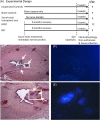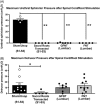Bladder reinnervation by somatic nerve transfer to pelvic nerve vesical branches does not reinnervate the urethra
- PMID: 31724210
- PMCID: PMC6980288
- DOI: 10.1002/nau.24217
Bladder reinnervation by somatic nerve transfer to pelvic nerve vesical branches does not reinnervate the urethra
Abstract
Aims: We sought to determine whether somatic lumbar nerve transfer to the pelvic nerve's anterior vesical branch after sacral decentralization for detrusor muscle reinnervation also leads to aberrant innervation of the bladder outlet.
Methods: Twenty-six female mongrel hound dogs underwent transection of sacral dorsal and ventral spinal roots (ie, sacral decentralization). Immediately afterward, 12 received genitofemoral nerve transfer and 9 received femoral nerve branch transfer. Five were left sacrally decentralized. Controls included 3 sham-operated and 6 unoperated. Eight months postsurgery, the bladder and urethra were injected with retrograde tracing dyes cystoscopically. After 3 weeks, detrusor and urethral pressures were assayed electrophysiologically immediately before euthanasia and characterization of neural reinnervation.
Results: Electrical stimulation of spinal cords or roots did not lead to increased urethral sphincter pressure in nerve transfer animals, compared with decentralized animals, confirming a lack of functional reinnervation of the bladder outlet. In contrast, mean detrusor pressure increased after lumbar cord/root stimulation. In sham/unoperated animals, urethral and bladder dye injections resulted in labeled neurons in sacral level neural structures (dorsal root ganglia [DRG], sympathetic trunk ganglia [STG], and spinal cord ventral horns); labeling absent in decentralized animals. Urethral dye injections did not result in labeling in lumbar or sacral level neural structures in either nerve transfer group while bladder dye injections lead to increased labeled neurons in lumbar level DRG, STG, and ventral horns, compared to sacrally decentralized animals.
Conclusion: Pelvic nerve transfer for bladder reinnervation does not impact urethral sphincter innervation.
Keywords: bladder reinnervation; nerve transfer; retrograde dye; somatic nerve; urethral sphincter.
© 2019 The Authors. Neurourology and Urodynamics published by Wiley Periodicals, Inc.
Figures





References
Publication types
MeSH terms
Grants and funding
LinkOut - more resources
Full Text Sources

